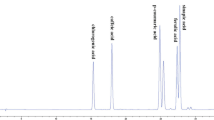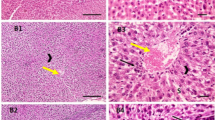Abstract
The present study was performed to investigate the protective effects of selenium (Se), vitamin E (Vit E) and anthocyanins from purple carrots and their combination against the oxidative stress induced by d-galactose in rats. A total of 80 male rats were equally divided into 11 groups, one of which acted as control (I) just receiving intraperitoneal injections of physiological saline. The remaining ten groups (II–XI) were intraperitoneally injected with d-galactose at a dose of 400 mg kg−1 body weight (BW) per day for 42 consecutive days. Rats in groups III–XI were treated with antioxidants via gavage per day as follows: group III: Se-methylselenocysteine (SeMSC), IV: Se as sodium selenite (Na2SeO3), V: Se-enriched yeast (SeY), VI: Vit E as α-tocopherol acetate, VII: anthocyanin from purple carrots (APC), VIII: APC + Vit E, IX: SeMSC + APC+ Vit E, X: Na2SeO3 + APC + Vit E, XI: SeY + Ant + Vit E. The results showed that the rats treated with antioxidants (III–XI) showed significant decreases in the levels of malondialdehyde (MDA) and carbonyl protein (PCO) compared with the d-galactose-treated group (II) in the heart, liver, kidneys, and blood. Moreover, there were significant increases in the activities of superoxide dismutase (SOD) and glutathione peroxidase (GSH-Px), glutathione (GSH) concentration, and total antioxidant capacity (T-AOC) in the heart, liver, kidneys, and blood of antioxidant-treated animals (III–XI) than those in control group (I). In addition, the combined treatments of two or three antioxidants showed greater antioxidant activities than those of individual treatments, suggesting the synergistic antioxidant effects of Se, Vit E, and APC. In conclusion, all the antioxidants exhibited protective effects against d-galactose-induced oxidative damage in rats, and these antioxidants showed a synergistic effect.







Similar content being viewed by others
References
Valko M, Leibfritz D, Moncol J, et al. (2007) Free radicals and antioxidants in normal physiological functions and human disease. Int J Biochem Cell B 39:44–84
Dröge W (2003) Oxidative stress and aging. Adv Exp Med Biol 543:191–200
Brenneisen P, Steinbrenner H, Sies H (2005) Selenium, oxidative stress, and health aspects. Mol Asp Med 26:256–267
Wang Y, Wu YC, Luo K, et al. (2013) The protective effects of selenium on cadmium-induced oxidative stress and apoptosis via mitochondria pathway in mice kidney. Food Chem Toxicol 58:61–67
Ebrahim AM, Eltayeb MAH, Shaat MK, et al. (2007) Study of selected trace elements in cancerous and non-cancerous human breast tissues from Sudanese subjects using instrumental neutron activation analysis. Sci Total Environ 383:52–58
Nazıroğlu M (2009) Role of selenium on calcium signaling and oxidative stress-induced molecular pathways in epilepsy. Neurochem Res 34:2181–2191
Nazıroǧlu M, Karaoğlu A, Aksoy AO (2004) Selenium and high dose vitamin E administration protects cisplatin-induced oxidative damage to renal, liver and lens tissues in rats. Toxicology 195:221–230
Nazıroğlu M (2007) New molecular mechanisms on the activation of TRPM2 channels by oxidative stress and ADP-ribose. Neurochem Res 32:1990–2001
Algarra M, Fernandes A, Mateus N, et al. (2014) Anthocyanin profile and antioxidant capacity of black carrots (Daucus carota L. ssp. sativus var. atrorubens Alef.) from Cuevas Bajas, Spain. J Food Compos Anal 33:71–76
Subarnas A, Wagner H (2000) Analgesic and anti-inflammatory activity of the proan-thoeyanidin shellegueain A from polypodium feei METT. Phytomedicine 7:401–405
Bagchi D, Sen CK, Bagchi M, et al. (2004) Anti-angiogenic, antioxidant, and anti-carcinogenic properties of a novel anthocyanin-rich berry extract formula. Biochem Mosc 69:75–80
Devi PS, Kumar MS, Das SM (2012) DNA damage protecting activity and free radical scavenging activity of anthocyanins from red Sorghum (Sorghum bicolor) bran. Bio Res Int 2012:1–9
Alvarez-Suarez JEM, Giampieri F, Tulipani S, et al. (2014) One-month strawberry-rich anthocyanin supplementation ameliorates cardiovascular risk, oxidative stress markers and platelet activation in humans. J Nutr Biochem 25:289–294
Lippman SM, Klein EA, Goodman PJ, et al. (2009) Effect of selenium and vitamin E on risk of prostate cancer and other cancers. JAMA 301:39
Kara H, Cevik A, Konar V, et al. (2008) Effects of selenium with vitamin E and melatonin on cadmium-induced oxidative damage in rat liver and kidneys. Biol Trace Elem Res 125:236–244
Hagiwara A, Miyashita K, Nakanishi T, et al. (2001) Pronounced inhibition by a natural anthocyanin, purple corn color, of 2-amino-1-methyl-6-phenylimidazo. Cancer Lett 171:15–25
Cefola M, Pace B, Renna M, et al. (2012) Compositional analysis and antioxidant profile of yellow, orange and purple Polignano carrots. Ita J Food Sci 24:284–291
Netzel M, Netzel G, Kammerer DR, et al. (2007) Cancer cell antiproliferation activity and metabolism of black carrot anthocyanins. Innov Food Sci Emerg 8:365–372
Head E, Nukala VN, Fenoglio KA, et al. (2009) Effects of age, dietary, and behavioral enrichment on brain mitochondria in a canine model of human aging. Exp Neurol 220:171–176
Chiu C, Chiu Y, Wu L, et al. (2011) Diosgenin ameliorates cognition deficit and attenuates oxidative damage in senescent mice induced by D-galactose. Am J Chinese Med 39:551–563
Hao L, Huang H, Gao J, et al. (2014) The influence of gender, age and treatment time on brain oxidative stress and memory impairment induced by D-galactose in mice. Neurosci Lett 571:45–49
Yu Y, Bai F, Wang W, et al. (2015) Fibroblast growth factor 21 protects mouse brain against D-galactose induced aging via suppression of oxidative stress response and advanced glycation end products formation. Pharmacol Biochem Be 133:122–131
Cho J, Kang JS, Long PH, et al. (2003) Antioxidant and memory enhancing effects of purple sweet potato anthocyanin and cordyceps mushroom extract. Arch Pharm Res 26:821–825
Coskun O, Kanter M, Korlmaz A, et al. (2005) Quercetin, a flavonoid antioxidant, prevents and protects streptozotocin-induced oxidative stress and beta-cell damage in rat pancreas. Pharmacol Res 51:117–123
Youdim KA, Shukitt-Hale B, MacKinnon S, et al. (2000) Polyphenolics enhance red blood cell resistance to oxidative stress: in vitro and in vivo. BBA-Gen Subjects 1523:117–122
Zhang Z, Fan S, Zheng Y, et al. (2009) Purple sweet potato color attenuates oxidative stress and inflammatory response induced by d-galactose in mouse liver. Food Chem Toxicol 47:496–501
Shireen KF, Pace RD, Mahboob M, et al. (2008) Effects of dietary vitamin E, C and soybean oil supplementation on antioxidant enzyme activities in liver and muscles of rats. Food Chem Toxicol 46:3290–3294
Mehmet K, Burhan A, Meryem A, et al. (2009) Vitamin E protects against oxidative damage caused by cadmium in the blood of rats. Eur J Gen Med 3:154–160
Lei C, Niu X, Ma X, et al. (2011) Is selenium deficiency really the cause of Keshan disease? Environ Geochem Hlth 33:183–188
Shi L, Xun W, Yue W, et al. (2011) Effect of sodium selenite, Se-yeast and nano-elemental selenium on growth performance, Se concentration and antioxidant status in growing male goats. Small Ruminant Res 96:49–52
Zhou X, Wang Y, Gu Q, et al. (2009) Effects of different dietary selenium sources (selenium nanoparticle and selenomethionine) on growth performance, muscle composition and glutathione peroxidase enzyme activity of crucian carp (Carassius auratus gibelio). Aquaculture 291:78–81
Chaudhary M, Garg AK, Mittal GK, et al. (2010) Effect of organic selenium supplementation on growth, Se uptake, and nutrient utilization in guinea pigs. Biol Trace Elem Res 133:217–226
Liu J, Zhao H, Liu Y, et al. (2012) Effect of two selenium sources on hepatocarcinogenesis and several angiogenic cytokines in diethylnitrosamine-induced hepatocarcinoma rats. J Trace Elem Med Bio 26:255–261
Yao Z, Zhang Y, Li H, et al. (2015) Synergistic effect of Se-methylselenocysteine and vitamin E in ameliorating the acute ethanol-induced oxidative damage in rat. J Trace Elem Med Bio 29:182–187
Suzuki KT, Tsuji Y, Ohta Y (2008) Preferential organ distribution of methylselenol source Se-methylselenocysteine relative to methylseleninic acid. Toxicol Appl Pharm 227:76–83
Battin EE, Brumaghim JL (2009) Antioxidant activity of sulfur and selenium: a review of reactive oxygen species scavenging, glutathione peroxidase, and metal-binding antioxidant mechanisms. Cell Biochem Biophys 55:1–23
Navarro-Alarcon M, Cabrera-Vique C (2008) Selenium in food and the human body: a review. Sci Total Environ 400:115–141
Rayman MP, Infante HG, Sargent M (2008) Food-chain selenium and human health: spotlight on speciation. Brit J Nutr 100:238–253
Hail N, Cortes M, Drake EN, et al. (2008) Cancer chemoprevention: a radical perspective. Free Radical Bio Med 45:97–110
Amara IB, Soudani N, Troudi A, et al. (2011) Antioxidant effect of vitamin E and selenium on hepatotoxicity induced by dimethoate in female adult rats. Ecotox Environ Safe 74:811–819
Shaheen NEM (2013) Oxidative stress of diethylnitrosamine on the functions of kidney in male rats and effective role of rutin and/or selenium. J Appl Sci Res 9:6684–6691
Shih P, Yeh C, Yen G (2007) Anthocyanins induce the activation of phase II enzymes through the antioxidant response element pathway against oxidative stress-induced apoptosis. J Agr Food Chem 55:9427–9435
Kasaikina MV, Turanov AA, Avanesov A, et al. (2013) Contrasting roles of dietary selenium and selenoproteins in chemically induced hepatocarcinogenesis. Carcinogenesis 34:1089–1095
Acknowledgments
This project was funded by the National Natural Science Funds of China (Grant No. 31301433) and the Postdoctoral Science Foundation of Jiangxi Province (Grant No. 2013KY04).
Author information
Authors and Affiliations
Corresponding author
Ethics declarations
All procedures involving rats were conducted in accordance with the guidelines of China for the care and use of laboratory animals.
Conflict of Interest
The authors declare that there are no conflicts of interest.
Rights and permissions
About this article
Cite this article
Li, X., Zhang, Y., Yuan, Y. et al. Protective Effects of Selenium, Vitamin E, and Purple Carrot Anthocyanins on d-Galactose-Induced Oxidative Damage in Blood, Liver, Heart and Kidney Rats. Biol Trace Elem Res 173, 433–442 (2016). https://doi.org/10.1007/s12011-016-0681-8
Received:
Accepted:
Published:
Issue Date:
DOI: https://doi.org/10.1007/s12011-016-0681-8




